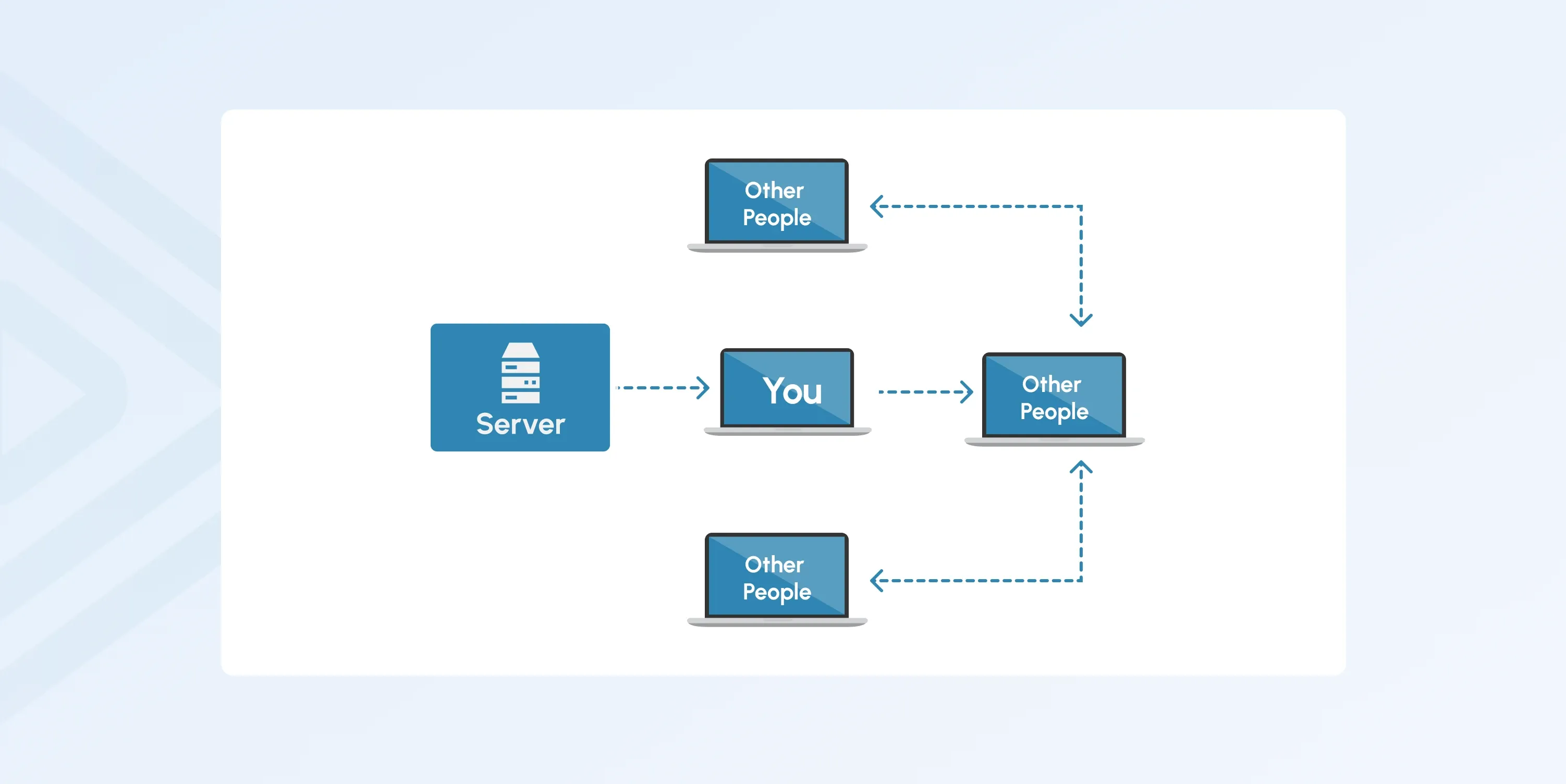
How to Cut Streaming Costs with P2P Streaming
As streaming quality rises and global audiences multiply, so do delivery expenses. ISPs, broadcasters, and TV operators now have to spend billions each year on data transit.
In some regions, like Asia and Latin America, bandwidth costs can exceed $40 per Mbps per month, compared to about $8-10 in North America. So, bandwidth costs grow, making it unsustainable to rely solely on CDN-based infrastructures.
This is where P2P (Peer-to-Peer) streaming comes into play. This delivery method offers a smarter, scalable way to share bandwidth among viewers, cutting down delivery costs without affecting performance.
If you're interested in saving bandwidth while streaming in high quality, this article is for you. Read on to learn how P2P streaming lowers your bandwidth costs without compromising quality and user experience.

What Is P2P Streaming?
Peer-to-Peer (P2P) streaming is a content delivery method in which viewers' devices share video data directly with one another rather than relying solely on a central server.
In traditional or live streaming, a server delivers content to each user individually through the nearest Content Delivery Network (CDN).
In P2P streaming, every viewer becomes both a consumer and a distributor of content.
So, with P2P, you reduce server load and improve delivery speed, making streaming more efficient and scalable for large audiences.
Example:
You're watching a live football match using P2P streaming.
Instead of every viewer pulling the stream from a central server, the first peer (you) receives the content from the server and then shares a portion of it with a nearby peer.
The latest does the same, passing the content to the next person, creating a chain of data-sharing that continues in real time.
How P2P Streaming Works
To see why P2P streaming is so effective, let's break down how it actually works.
Below, you'll find the core process that makes this technology faster and more efficient than traditional delivery methods.

1. Content Segmentation and Distribution
Instead of each user pulling content from a single server, P2P video streaming creates a distributed network where users (peers) share data in real time.
2. Peer Discovery
Peers (users) in the network find each other using a tracker or a DHT (Distributed Hash Table). Each peer in the network can download and upload parts of the content. Once a peer downloads a part, it can be shared with other peers.
3. Real-Time Streaming and Data Sharing
As the content streams, peers continuously exchange data, ensuring smooth playback. Each peer downloads specific parts from the source and immediately shares them with others in real time.
This synchronized data exchange keeps the stream flowing without interruptions, which reduces reliance on the original server.
4. Dynamic Distribution
As more peers join the peer-to-peer network, they share content chunks with new users, distributing the load across multiple devices.
This reduces dependence on the original server and makes streaming more scalable, even during high-traffic events.
So, here is what happens in four simple steps:
Step 1: The content (video, a file, or audio) is divided into small pieces.
Step 2: User devices connect within the shared network to locate and exchange content.
Step 3: Each user downloads chunks while simultaneously uploading them to others.
Step 4: The separate parts of the content are put back together for smooth playback on each user's device.
This system works like clockwork, delivering high-quality performance, low latency, and adaptive bitrate streaming to every user. The best part? Server load is dramatically reduced.
The Benefits of P2P Streaming
P2P streaming is a more adaptive architecture built for the future of content distribution. It brings several technical advantages that directly impact the performance, scalability, and cost-efficiency of your content delivery.
1. Lower Bandwidth Costs Through Shared Delivery
Instead of routing every stream through expensive CDN servers, P2P streaming distributes video chunks among viewers. This shared traffic model can reduce CDN dependency by up to 20-40%, significantly lowering operational costs for ISPs, broadcasters, and OTT providers.
2. Enhanced Scalability Without Extra Infrastructure
As viewership grows, so does the strength of a P2P network. Each new peer adds bandwidth capacity, creating a system that scales naturally without extra servers or data centers. This makes it ideal for large events, viral content, or global live streams.
3. Faster, More Stable Playback
P2P streaming uses smart peer-discovery and chunk-distribution algorithms to deliver content from the closest, fastest peers. This minimizes buffering, balances network load, and keeps video playback consistent even during traffic spikes or regional outages.
4. Reduced Latency with Localized Data Exchange
Because P2P networks route data through nearby peers rather than distant servers, latency drops significantly. This results in faster start times and smoother performance for live events, sports, or interactive streaming experiences.
5. Environmentally Friendly Streaming
By lowering reliance on centralized servers and global CDN traffic, P2P streaming cuts data center power usage and reduces carbon emissions. Each shared connection contributes to a greener, more sustainable streaming ecosystem.
6. Better Network Resilience
A distributed network is less vulnerable to single points of failure. If one route or peer fails, the system automatically reroutes traffic to other routes or peers. This ensures reliable delivery even during outages or congestion.
Use Cases for Peer-to-Peer Streaming
No matter the type of content or the industry you're in, P2P streaming plays a vital role in keeping delivery fast, stable, and affordable. From entertainment and gaming to education and real-time communication, it helps handle large audiences without overloading servers or increasing bandwidth costs.
Gaming and E-Sports
In gaming, P2P streaming supports e-sports broadcasts, live gameplay, and even patch distribution for updates. Players share data directly, reducing download times, latency, and server load-crucial for both performance and cost control.
Education and E-Learning
Online education platforms benefit from P2P delivery in virtual classrooms and mass courses where thousands join simultaneously. Students can also collaborate and share content instantly, keeping lessons interactive without overwhelming the network.
Video Conferencing and Real-Time Communication
For meetings, webinars, and enterprise communication, P2P streaming connects participants directly to each other. This lowers latency, reduces server dependence, and ensures smoother video calls-even for global teams.
Social Media and User-Generated Content
In social apps where users constantly upload and stream videos, P2P sharing spreads bandwidth demand across the audience. It's especially effective for live social streams, where viewers help distribute the video in real time.
VOD and Live Streaming in OTT Platforms
This approach allows OTT platforms to deliver seamless playback to thousands of concurrent viewers, maintaining high performance even during peak hours or live events. It also helps optimize traffic distribution across regions, ensuring consistent viewing quality no matter where your audience is.
Tip: If you want to start P2P streaming, partner with a vendor that already has the technology and expertise in place.
That's where the right technology partner makes all the difference.
With inoRain's white-label OTT platform, powered by a fully integrated P2P streaming solution, you can instantly reduce bandwidth costs while keeping every stream fast, reliable, and high-quality across web, mobile, and smart TV devices.
Potential Challenges and Limitations
While P2P streaming delivers impressive performance and cost savings, it also comes with challenges that you should be prepared to manage.
External conditions like user behavior, network quality, and device performance can all influence how well your system runs.
Here are three main problems you may experience:
Peer Behavior
Because P2P streaming depends on users sharing data, the behavior of peers directly affects network performance. Some may engage in free-riding, downloading content without contributing their bandwidth back to others, which weakens the overall efficiency.
Others might disconnect suddenly (churn), causing gaps in data availability and brief playback interruptions.
In rare cases, malicious peers could attempt to send corrupted data, threatening content integrity and user experience.
Additionally, users behind NATs or firewalls may face connection issues, limiting their ability to share data directly with other peers.
Resource Utilization
Each peer device contributes its own processing power, bandwidth, and energy to the network. This means P2P streaming can be demanding on devices, especially when it comes to CPU and memory usage.
On mobile platforms, constant uploading and downloading can increase battery consumption, which might frustrate users if not optimized.
Technical Complexities
Building and maintaining a reliable P2P streaming system requires strong technical expertise. You'll need to design efficient algorithms for chunk distribution, peer discovery, and fault tolerance to ensure smooth playback.
Compatibility is another challenge - P2P connections behave differently across devices, operating systems, and network environments, making universal performance tuning a continuous task.
However, with proper architecture design, hybrid CDN integration (more on this later), and continuous monitoring, these challenges can be minimized, keeping your P2P infrastructure scalable and stable.
Addressing P2P Streaming Challenges
Most of the challenges mentioned above have practical, real-world solutions that can be implemented immediately.
Here are some of the key strategies ISPs and TV operators use to overcome technical obstacles - and you can apply them, too:
Using hybrid models (P2P + server-based delivery) for extra reliability
Combine peer-to-peer sharing with traditional CDN or origin servers. This way, your stream continues smoothly even if peer connections drop. The server acts as a backup source, ensuring stable playback under any network condition.
Incorporating encryption and verification mechanisms for security
Always encrypt video chunks before sending them to peers. Use token-based authentication or DRM (Digital Rights Management) to verify each peer's access rights. This keeps your content safe from interception or unauthorized redistribution.
Motivating peers to share resources and reduce free-riding
Encourage users to upload as much as they download by rewarding active participation. You can prioritize peers who contribute more bandwidth or data. This keeps the network balanced and efficient.
Optimizing peer discovery and chunk distribution algorithms to ensure efficient data flow
Use intelligent trackers or decentralized discovery methods to connect peers quickly. Distribute video chunks dynamically based on proximity, speed, and availability. This improves delivery speed and reduces buffering across your network.
Ready to Start P2P Streaming?
Video traffic already accounts for roughly 82% of global consumer internet traffic, so efficient content distribution is needed to grow any streaming business.
P2P is the technology that allows you to achieve cost-efficiency while solving multiple streaming challenges in a single process.
With advanced P2P streaming technology, custom solutions, and robust features, inoRain helps ISPs, TV operators, and content creators deliver seamless, high-quality streaming at scale.
Our technology reduces your bandwidth expenses by up to 20%, while keeping your streams fast, stable, and high-quality.
Talk to inoRain's experts to learn more.
Frequently Asked Questions
Co-founder / CTO
Armen is the CTO and Co-Founder of inoRain OTT and Co-Founder of HotelSmarters, specializing in advanced streaming technologies, OTT strategy, and interactive TV systems. He builds scalable end-to-end video delivery solutions and drives technical innovation across hospitality and streaming platforms, bridging complex engineering with practical business impact.

OTT Advertising: Types, Best Practices, and Strategies
Over-the-top (OTT) advertising has transformed how brands connect with consumers.

VPlayed Alternatives: inoRain vs. VPlayed
Explore inoRain as a VPlayed alternative, comparing features, pricing, and OTT solutions to find the best platform for your streaming needs.

Custom OTT Platform Development: How to Start an OTT Business
This guide will walk you through everything you need to know about the OTT platform development.
